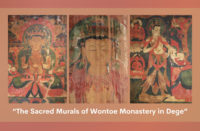
Last week Forbes magazine announced that J.K Rowling, the author of Harry Potter, a story about a boy Wizard is the highest earning author and number one celebrity author in the world. Did we Tibetans contribute anything to this? It seems that the Tibetans will be making a modest contribution to her monthly income of three million dollars.
I always look forward to the arrival of a neatly packed box of books from Tibet; this has been rudely interrupted since March. Last week, to my surprise, the supply resumed and I excitedly opened the box. On the top of the pile of books was a Tibetan translation of Harry Potter and the Philosopher’s Stone, (published in the United States as Harry Potter and the Sorcerer’s Stone). Actually, dont you think this is a bit of an insult to the Yanks? The publisher may have assumed the word philosopher could confuse American readers. Anyway, the Tibetan translation retains the original title. The photo above is the Tibetan cover of the book.
At quick glance it is clear the book has not been translated from English but from Chinese. This often happens these days. The rendering title sounds like Harus Potter in Tibetan. The translator Norkyil Buchung Gyal (????????????????????) in his preface writes that the chief motive for translating is to provide Tibetan language reading materials for junior middle school age groups. Certainly, there is a total lack of reading materials in Tibetans for young people. I for one welcome the publication.
Hopefully, there are many more to come!





I don’t understand how they “preserved the original title” of Philosopher’s Stone. It’s actually true that everyone assumes that Americans are ignorant of alchemy in a way that Europeans are more likely not to be. (Popular TV culture is aimed at 15-year-olds.) But the Tibetan title Tse Do (Tshe Rdo) means ‘Life Stone.’ It doesn’t mean anything particular in Tibetan culture, does it? Although it might evoke connections with Tsewang (Tshe-dbang, Long Life Empowerment), Tsering (Tshe-ring, Long Life), Tsebum (Tshe-bum, Life Vase) or the like. Or do you know something you’re not telling us? This seems to be the likely explanation. I also think it’s great that Tibetan language will get all kinds of translations from foreign literature. I’ve seen several translations of Shakespeare come out recently.
Gosh, I am honoured by your visit.
Isn’t one of the meanings of the Philosopher’s Stone The elixir of life? Hence Tshe but of course, tshe rdo has no real meaning in Tibetan and the closest term to elixer of life I can think of is tshe ril. Tshe ril only gives you longevity not immortality. The exact term of the elixir of life would be bdud rtsi, but I doubt many people would have understood the word and of course only CCP has the power to grant bdud rtsi. I cannot think of any other esoteric linkage that might be understood by Tibetan readers. A more interesting and meaningful translation would be Tshe nor (Lifes jewel or life granting jewel.)
I have seen the Tibetan translation of Hamlet and Macbeth, the only other recent translation I know is Laxmi Prasad Devkotas Muna Madan, the most famous Nepali epic love story. Part of the poem is set in Lhasa when Madan travels to Lhasa, interesting, it was also translated not from Nepali but from Michael Hutts English translation. For some strange reason the book is not on sale in Tibet and it is hard to obtain. I was told the translation was done as a part of celebration of Nepal-China friendship and given as a present to visiting Nepali big wigs.
Hi High (or is that you, Hugh) ;.?,
I was thinking that the Indian idea of Cintamani, in Tibetan Yizhin Norbu (Yid bzhin nor bu), the Wishgranting Jewel, although still not quite “it,” could have been made to work.
But the Philosopher’s Stone is perhaps the most elusive of all those deeply encoded alchemical concepts, because if you can find out what it is exactly, you will almost certainly succeed in the Work. It isn’t even really a
stone.
I also noticed this one in a book catalog:
Sheg si pe yar, Ro me’o dang ju li kri (Lhasa 2003).
The following comment was submitted via e-mail by chosnyid:
Harry Potter in Tibetan is definitely a translation from Chinese. It is hard these days to find in China a Tibetan educated enough both in Tibetan and English… The Shakespeare translations were made directly from the original English version by Bkras gling Dbang rdor, who once studied English in a missionary college in Northern India, before Tibet was “liberated”… Bkras gling Dbang rdor is over 70 years old, and who is to take over the task?
A Tibetan monk in India has translated Gora (I think) by Tagore, into Tibetan, 2 years ago. Phun nor, from Rgyal rtse, working at TAR Radio, has translated Goethe’s The Sorrow of Young Werther into Tibetan, but from Chinese once again. He is currently working on a play by Molière – once again from Chinese – I think it is Le Tartuffe. He has already agore into Tibetan.
A Tibetan middle-school teacher recently complained in a well written article (in Tibetan) that most educational stuff for Tibetan children was translated from Chinese. We all know that, but isn’t it a pity (she goes on to say) that it should include material used to teach Tibetan language?”
Thank you Chos-nyid, that’s fascinating stuff. I’d never heard of the Moliere, but I’d love to know more.
I was thinking you or High or both could help me with my list of Hans Christian Anderson fairy tale translations. Sorry, I don’t personally own any of these, and don’t remember even seeing them. I found them in listings of Tibetan books. So I had to guess what they are by their Tibetan titles, not always successfully! Anderson appears as An-thu-hran (sometimes An-thu’u-hran), very much looking like Chinese is hiding behind the Tibetan spelling. Here they are:
Hans Christian Anderson (1805-1875)
An thu hran, Me lcags (Beijing 2002). The Tinder Box.
An thu hran, Mtheb mdzub ma (Beijing 2002), “An thu hran gyi byis sgrung.” Thumbelina.
An thu hran, Ngang pa (Beijing 2002). Ugly Duckling [?].
An thu’u hran, Rta lpags kyi sprul rkyal (Beijing 2002).” The fairy tale about the magical bag of horse hide. It’s found in the collection Little Claus and Big Claus (free e-text on internet).
An thu hran, Ya phrug mdog nyes (Beijing 2002).
For Tagore, Françoise Robin of Paris wrote a very interesting piece recently. In French, of course.
Tagore au Tibet, Revue d’Etudes Tibétaines, vol. 7 (April 2005), pp. 22-40.
You can find it and download it for free over the internet http://tinyurl.com/4txghn
Everyone ought to learn French, right after Tibetan.
Dear Dan,
As far as I can tell, there is a small confusion here :
An thu hran, Ya phrug mdog nyes (Beijing 2002) would be The Ugly Duckling (ya = Ch. yazi, for duck, and mdog nyes = ugly).
– Ngang ba would have to be The Wild Swann then.
There is a good article by Lara Maconi (in French “of course”, which proves Dan is right once again), called “Une longue marche translinguistique”, in France-Asie: Un siècle d’échanges littéraires, 2001, Paris : You-Feng. It deals with translations of French literature into Tibetan, mainly via Chinese.
Dear Dharmatâ,
You must be right. I do wonder about The Ugly Little Yazi, though. That sort of yazi wouldn’t do well in this business, would he?
I had better duck before somebody hits me.
Mind you : ugly little yazi may surprise you and turn out to be fit for the kind of job you are referring to – for a Tibetan sort-of-equivalent (but not quite though), see the story of a little ugly frog that turned out to be a wonderful prince in disguise – a story found in Mi ro rtse sgrung (a version of Ro sgrung published in Xining in 1963 and republished since), under the title “Sbal ba dang sras mo”. This tale can be found in Chophel’s Tibetan Folk Tales (1994) under the title “The Frog who married the princess” and “The Frog and the Princess”. See also “The Princess and the Frog” in “Tales of the Golden Corpse” retold by Sandra Benson (Interlink Books, 2007). And I do know include the “of course” French translation published in 2006 by you (maybe) guess who.
wow. i want a copy of that SO badly
Hello, I will be visiting Tibet in about a month. Where can I buy a Tibetan copy of Harry Potter? It’s quite important.